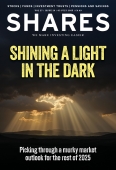Archived article
Please note that tax, investment, pension and ISA rules can change and the information and any views contained in this article may now be inaccurate.
S&P 500 and Nasdaq hit new highs after best quarter in more than a year

Risk assets are back with a bang, with the S&P 500 and the Nasdaq Composite closing at record highs on Monday (30 June), after a frantic rally off the lows at the start of the second quarter triggered by ‘Liberation Day’.
The whole idea of introducing swingeing tariffs was to bring countries to the table, yet as we approach the end of the 90-day reprieve the US has done a trade deal of sorts with the UK and tensions with China have de-escalated, but Europe and Japan have yet to acquiesce.
Treasury Secretary Scott Bessent insists that unless countries act before 9 July, there will be a ‘bounce-back’ to the tariffs announced on 2 April.
Yet where is the worry? Why aren’t stocks selling off again? The answer is, investors – and we are mainly talking about US retail investors – are getting more comfortable with ‘buying the dip’, because history tells them it is a winning strategy over the long term.
Meanwhile, the US Senate is pushing through legislation which will add at least another $3.5 trillion to the budget deficit, so why aren’t bond yields blowing out the way they did earlier in the year?
The US 30-year Treasury yield is currently around 4.75%, not 5.15%, because the market knows as soon as Fed chairman Jerome Powell’s term is up next May, the new appointee – quite possibly Bessent – will slash interest rates at the president’s bidding, regardless of where inflation may be at the time.
The strain is being borne entirely by the dollar, which in the space of three months has hit a three-year low.
Unfortunately, as bond investors know, cutting short-term interest rates doesn’t mean long-term rates will necessarily fall, reducing the interest bill – in fact they can actually rise.
So, while it may look as though risks are contained, due to the lack of volatility, stresses are growing within the market.
That might not be such a problem if stocks weren’t so richly valued, but based on Monday’s closing price the S&P 500 is the most expensive it has been since the internet bubble in 2000, while earnings forecasts are being cut, not raised.
Back in the day, the phrase was ‘There’s an app for that’. Now the phrase is, ‘There’s an ETF for that’, as Martin Gamble reports in his feature on a new actively-managed high-yield ETF which has been backed by a mysterious ‘whale’ investor to the tune of $2 billion.
And, after celebrating 30 years of AIM recently, this week sees the UK’s oldest stock market indicator turn 90. We look at how the index has evolved since its formation and discover a few rare survivors from the 1930s.
Important information:
These articles are provided by Shares magazine which is published by AJ Bell Media, a part of AJ Bell. Shares is not written by AJ Bell.
Shares is provided for your general information and use and is not a personal recommendation to invest. It is not intended to be relied upon by you in making or not making any investment decisions. The investments referred to in these articles will not be suitable for all investors. If in doubt please seek appropriate independent financial advice.
Investors acting on the information in these articles do so at their own risk and AJ Bell Media and its staff do not accept liability for losses suffered by investors as a result of their investment decisions.
 magazine
magazine








